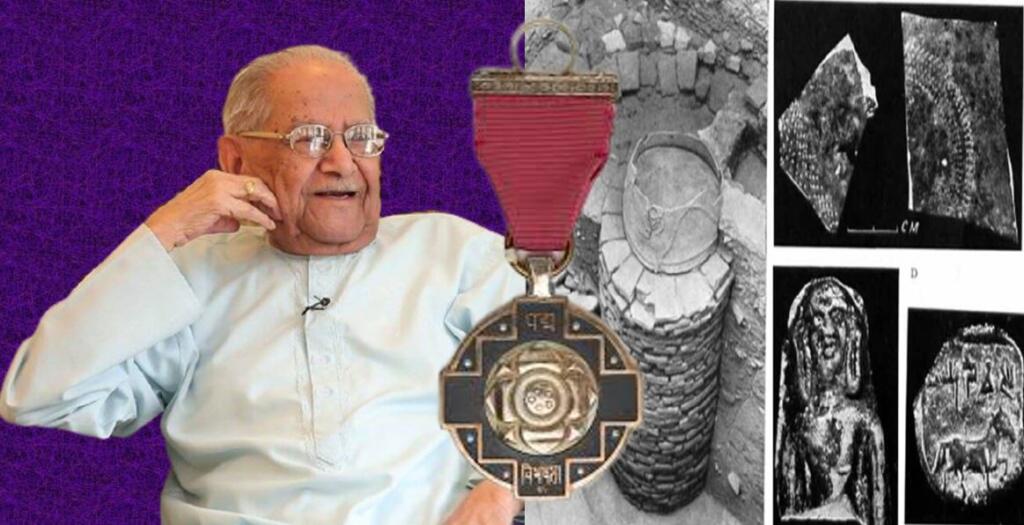Braj Basi Lal, the 100-year-old veteran archaeologist, who proved the existence of Padmalochana Sri Ram’s mandir beneath the site of Babri Masjid, has been awarded Padma Vibhushan, the second-highest civilian award of the country.
Mr. Lal was the Director-General of Archaeological Survey of India between1968−1972, and his work on the sites of Mahabharata and Ramayana proved crucial in proving their historical authenticity.
After completing Post Graduation in Sanskrit in 1943, he served as a trainee in the excavation under the renowned British archaeologist Mortimer Wheeler, and began his career as an archaeologist from the site of Taxila.
Also read: ASI’s role was pivotal in the Ayodha verdict, now it is set to go to Varanasi for excavations
In the course of over 50 years, Lal worked on over 50 books and 150 research papers published in national and international journals. Some of his most notable books include, ‘The Saraswati flows on: The continuity of Indian culture’ published in 2002 and ‘Rama, his Historicity, Mandir and Setu: Evidence of Literature, Archaeology and other Sciences’ published in 2008.
He found that there existed a historical premise for the Mahabharata story, although the events were greatly exaggerated in the book. On the lines of the investigations carried out in the Mahabharata sites, Lal started working on Ramayana sites in 1975 under the project titled ‘Archaeology of the Ramayana sites’.
The project was funded by the ASI, Jiwaji University (Gwalior), and the Department of Archaeology in the government of Uttar Pradesh. The project was inaugurated at Ayodhya on March 31, 1975. It excavated five Ramayana-related sites, including Ayodhya, Bharadwaj Ashram, Nandigram, Chitrakoot, and Shringaverapura.
B. B. Lal’s work in Ayodhya:
In his 1975 paper, Lal wrote about the ongoing excavation at Ayodhya and argued about the presence of structures that date back to the 8th century, hundreds of years before the construction of Babri Masjid. In 1990, after the excavations were completed, Mr. Lal wrote about the existence of ‘pillar-base structures’ which were fully separate from the Masjid structure.
“Attached to the piers of the Babri Masjid, there were twelve stone pillars, which carried not only typical Hindu motifs and mouldings, but also figures of Hindu deities. It was self-evident that these pillars were not an integral part of the Masjid, but were foreign to it,” Lal wrote.
These findings became the basis of the High Court’s judgment and later of the Supreme Court’s judgment. Despite the repeated attempts by the cabal of Marxist historians of the country (who had done very little work on archaeology and were more concerned about ideology and narrative rather than the truth), the work of people like B. B. Lal and K. K. Muhammed ensured the rightful victory of the Hindus in the Ram Janambhoomi case.
BJP rewards rightful people:
Former regional director (north) of the Archaeological Survey of India, Shri K. K. Muhammed was the other person who was crucial in proving the existence of a Hindu structure at the disputed site. Against a horde of historians-turned-‘distorians’, K. K. Muhammed stood strong and asserted the importance and legitimacy of ASI’s archaeological findings in Ayodhya. K. K. Muhammad was awarded Padma Shri, the fourth highest civilian honor of the government of India, in 2019.
After the Ayodhya verdict was pronounced, K. K. Muhammed felt elated. In a conversation with ANI, he said, “On the basis of archaeological & historical evidences that were supplied by ASI, court came to conclusion that there was a huge magnificent temple earlier & we should build a new temple once more.”
Also read: Modi government lays the groundwork for reclaiming Kashi Vishwanath Mandir
B. B. Lal was awarded Padma Bhushan in 2000 by the Atal Bihari Vajpayee government for his seminal contribution to Indian archaeology. And now, the Modi government has further recognized his work on historical sites including River Saraswati and Ayodhya by awarding him the second-highest honor (Padma Vibhushan) of the Government of India. In the last few years, the Padma awards have been democratized and the contribution of actual karma yogis are being recognized under ‘People’s Padma’ rather than of the Darbari historians and journalists, which was the norm for around seven decades of Congress party’s misgovernance.
